
- Home
- Frame Size
- Framing
- Material
- Acrylglass (14)
- Acrylic (9)
- Canvas (318)
- Canvas Giclee Print (62)
- Canvas, Paper (15)
- Color Plate (16)
- Etching (8)
- Giclee & Iris (15)
- Glass (50)
- Gloss Paper (72)
- Leather (14)
- Lithograph (27)
- Matte Paper (21)
- Offset Lithograph (46)
- Paper (229)
- Paper Or Canvas (17)
- Papier (39)
- Pine (10)
- Print (30)
- Saffiano Leather (8)
- Other (3893)
- Subject
- Abstract (127)
- Abstract Art (52)
- Aircraft (19)
- Animals (43)
- Birds (26)
- Boxing (30)
- Dismaland (19)
- Fantasy (41)
- Figures (43)
- Figures & Portraits (48)
- Landscape (75)
- Love (25)
- Military & Political (20)
- Movies (58)
- Nudes (24)
- Politics (23)
- Portrait (52)
- Street Art (130)
- Vogue (24)
- Women (18)
- Other (4016)
- Theme
- Type
- Canvas (20)
- Canvas Picture (7)
- Canvas Print (61)
- Comic Book (2)
- Engraving (4)
- Etching (3)
- Framed Print (3)
- Framed Prints (7)
- Lithograph (15)
- Photograph (3)
- Picture / Print (57)
- Poster (43)
- Print (1436)
- Prints (3)
- Skateboard (3)
- Stretcher Bars (2)
- T-shirt (3)
- Vintage Art Print (3)
- Wall Art (64)
- Wall Mirror (6)
- Other (3168)
Knight Sir Ernest H Shackleton Explorer South Pole Touring Banner Poster
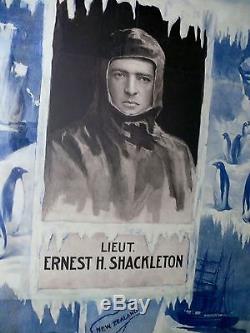
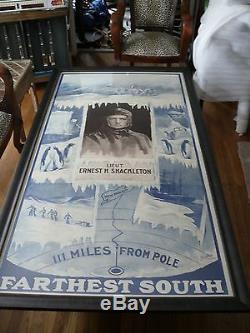
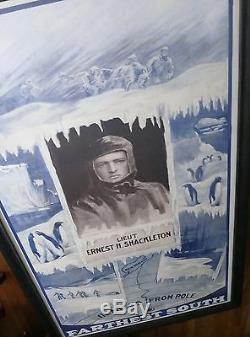
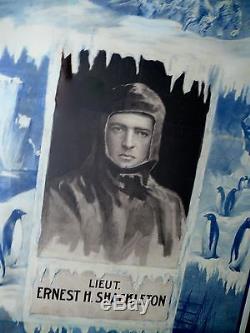
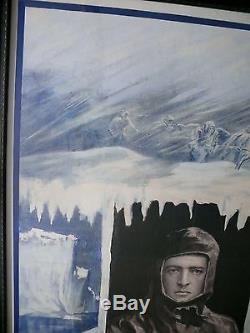
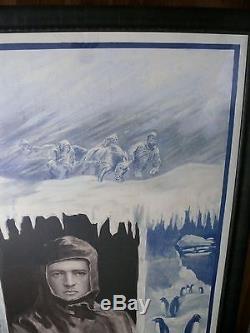
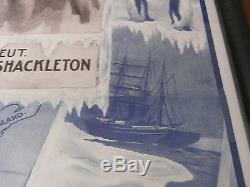
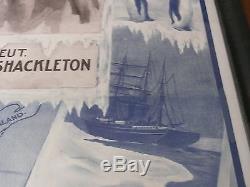
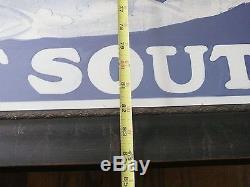
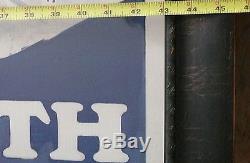
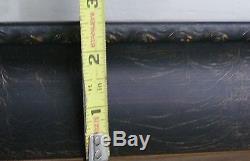
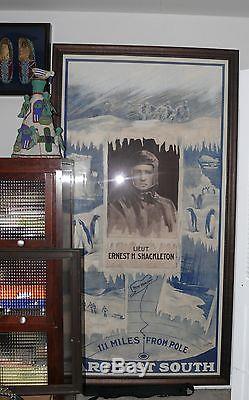


RARE LIEUTENANT ERNEST SHACKLETON SOUTH POLE EXPLORATION TOURING BANNER. RESTORED AND LINEN BACKED MUSEUM FRAMED 7 FEET IN HEIGHT HAVE LEFT OUT IMAGES ON BANNER TO PROTECT AUTHENTICITY. MUSEUM FRAMED PLEASE SEE RESTORATION VIDEO BOTTOM OF DESCRIPTION. From Wikipedia, the free encyclopedia.
Shackleton as a young man. 5 January 1922 (aged 47) South Georgia Island. Sir Ernest Henry Shackleton , CVO. (15 February 1874 5 January 1922) was an Anglo-Irish.Who was one of the principal figures of the period known as the Heroic Age of Antarctic Exploration. His first experience of the polar regions was as third officer on Captain Robert Falcon Scott.
190104, from which he was sent home early on health grounds. In January 1909 he and three companions made a southern march which established a record Farthest South. Latitude at 88° 23 S, 97 geographical miles. 190 km from the South Pole. By far the closest convergence in exploration history up to that time.
For this achievement, Shackleton was knighted by King Edward VII. After the race to the South Pole ended in 1912 with Roald Amundsen. S conquest, Shackleton turned his attention to what he said was the one remaining great object of Antarctic journeyingthe crossing of the continent from sea to sea, via the pole.
To this end he made preparations for what became the Imperial Trans-Antarctic Expedition. Was trapped in pack ice.
And slowly crushed, before the shore parties could be landed. There followed a sequence of exploits, and an ultimate escape with no lives lost, that would eventually assure Shackleton's heroic status, although this was not immediately evident.
In 1921 he went back to the Antarctic. Intending to carry out a programme of scientific and survey activities. Was moored in South Georgia.
At his wife's request he was buried there. Away from his expeditions, Shackleton's life was generally restless and unfulfilled. His financial affairs were generally muddled; when he died he was heavily in debt. On his death he was lauded in the press, but was thereafter largely forgotten, while the heroic reputation of his rival Scott was sustained for many decades.
At the end of the 20th century Shackleton was "rediscovered". And rapidly became a cult figure, a role model for leadership as one who, in extreme circumstances, kept his team together to accomplish a survival story which polar historian Stephanie Barczewski describes as "incredible". South London (a modern photograph).
Ernest Shackleton was born on 15 February 1874, in Kilkea near Athy. Ireland, about 30 miles (48 km) from Dublin. Ernest's father was Henry, and his mother was Henrietta Letitia Sophia Gavan. His father's family was Anglo-Irish.His mother's family was Irish, from counties Cork. Ernest was the second of their ten children and the first of two sons; the second, Frank, would achieve notoriety as a suspect, later exonerated, in the 1907 theft of Ireland's Crown Jewels. In 1880, when Ernest was six, Henry Shackleton gave up his life as a landowner to study medicine at Trinity College, Dublin. Moving his family into the city. Four years later, the family moved again, from Ireland to Sydenham.
Partly this was in search of better professional prospects for the newly qualified doctor, but another factor may have been unease about their Anglo-Irish ancestry, following the assassination by Irish nationalists of Lord Frederick Cavendish. The British Chief Secretary for Ireland, in 1882. From early childhood Shackleton was a voracious reader, which sparked a passion for adventure.
He was schooled by a governess until the age of eleven, when he began at Fir Lodge Preparatory School in West Hill, Dulwich. At the age of thirteen, he entered Dulwich College. The young Shackleton did not particularly distinguish himself as a scholar, and was said to be "bored" by his studies. He was quoted later as saying: I never learned much geography at school.... Literature, too, consisted in the dissection, the parsing, the analysing of certain passages from our great poets and prose-writers... Teachers should be very careful not to spoil [their pupils'] taste for poetry for all time by making it a task and an imposition.In his final term at the school, however, he was still able to achieve fifth place in his class of thirty-one. Shackleton's restlessness at school was such that he was allowed to leave at 16 and go to sea. The options available were a Royal Naval cadetship at HMS Britannia.
Which Dr Shackleton could not afford, the mercantile marine cadet ships Worcester. Or an apprenticeship "before the mast" on a sailing vessel. The third option was chosen. During the following four years at sea, Shackleton learned his trade, visiting the far corners of the earth and forming acquaintances with a variety of people from many walks of life, learning to be at home with all kinds of men. In August 1894 he passed his examination for Second Mate.
And accepted a post as third officer. Of the Welsh Shire Line.Two years later he had obtained his First Mate. In 1898 Shackleton joined the Union-Castle Line.
He was, as a shipmate recorded, "a departure from our usual type of young officer", content with his own company though not aloof, "spouting lines from Keats [and] Browning", a mixture of sensitivity and aggression but, withal, sympathetic. Following the outbreak of the Boer War. In 1899, Shackleton transferred to the troopship Tintagel Castle where, in March 1900, he met an army lieutenant, Cedric Longstaff, whose father Llewellyn W. Was the main financial backer of the National Antarctic Expedition. Then being organised in London. Shackleton used his acquaintance with the son to obtain an interview with Longstaff senior, with a view to obtaining a place on the expedition. Longstaff, impressed by Shackleton's keenness, recommended him to Sir Clements Markham. The expedition's overlord, making it clear that he wanted Shackleton accepted. In the Royal Naval Reserve. Although officially he was given leave by Union-Castle, this was in fact the end of Shackleton's Merchant Navy service. Was the brainchild of Sir Clements Markham, president of the Royal Geographical Society. And had been many years in preparation. It was led by Robert Falcon Scott. A Royal Navy torpedo lieutenant lately promoted Commander.And had objectives that included scientific and geographical discovery. Shackleton accepted this, even though his own background and instincts favoured a different, more informal style of leadership. In charge of holds, stores and provisions...
He also arranges the entertainments. Discovery departed London on 31 July 1901, arriving at the Antarctic coast, via Cape Town. After landing, Shackleton took part in an experimental balloon flight on 4 February. He also participated, with the scientists Edward Wilson.
And Hartley Ferrar, in the first sledging trip from the expedition's winter quarters in McMurdo Sound. A journey which established a safe route on to the Great Ice Barrier.During the Antarctic winter of 1902, in the confines of the iced-in Discovery , Shackleton edited the expedition's magazine The South Polar Times. According to steward Clarence Hare.
He was "the most popular of the officers among the crew, being a good mixer". Though claims that this represented an unofficial rival leadership to Scott's are unsupported. Scott chose Shackleton to accompany Wilson and himself on the expedition's southern journey, a march southwards to achieve the highest possible latitude in the direction of the South Pole. This march was not a serious attempt on the Pole, although the attainment of a high latitude was of great importance to Scott, and the inclusion of Shackleton indicated a high degree of personal trust.
The party set out on 2 November 1902. The march was, Scott wrote later, "a combination of success and failure". Latitude of 82° 17 was reached, beating the previous record established in 1900 by Carsten Borchgrevink.
The journey was marred by the poor performance of the dogs, whose food had become tainted, and who rapidly fell sick. All 22 dogs died during the march. The three men all suffered at times from snow blindness, frostbite and, ultimately, scurvy. On the return journey Shackleton had by his own admission "broken down" and could no longer carry out his share of the work. He would later deny Scott's claim in The Voyage of the Discovery , that he had been carried on the sledge.
After a medical examination (which proved inconclusive). Which had arrived in McMurdo Sound in January 1903. Scott wrote: He ought not to risk further hardship in his present state of health. There is conjecture that Scott's motives for removing him was resentment of Shackleton's popularity, and that ill-health was used as an excuse to get rid of him. Years after the deaths of Scott, Wilson and Shackleton, Albert Armitage. There is no corroboration of Armitage's story. Shackleton and Scott stayed on friendly terms, at least until the publication of Scott's account of the southern journey in The Voyage of the Discovery. Although in public they remained mutually respectful and cordial. According to biographer Roland Huntford, Shackleton's attitude to Scott turned to "smouldering scorn and dislike"; salvage of wounded pride required "a return to the Antarctic and an attempt to outdo Scott". Between the Discovery and Nimrod expeditions, 190307. Ernest Shackleton's wife, née Emily Dorman. As the first significant person to return from the Antarctic he found that he was in demand; in particular, the Admiralty wished to consult him about their further proposals for the rescue of Discovery.With Sir Clements Markham's blessing he accepted a temporary post assisting the outfitting of the Terra Nova for the second Discovery relief operation but turned down the offer to sail with her as chief officer. He also assisted in the equipping of the Argentinian corvette Uruguay. Which was being fitted out for the relief of the stranded Swedish Antarctic Expedition.
In search of more permanent employment, Shackleton applied for a regular commission in the Royal Navy, via the back-door route of the Supplementary List. But despite the sponsorship of Markham and of the president of the Royal Society. Instead, he became a journalist, working for the Royal Magazine. He was then offered, and accepted, the secretaryship of the Royal Scottish Geographical Society. (RSGS), a post which he took up on 11 January 1904.
In 1905 Shackleton became a shareholder in a speculative company that aimed to make a fortune transporting Russian troops home from the Far East. Despite his assurances to Emily that "we are practically sure of the contract" nothing came of this scheme. He also ventured into politics, unsuccessfully standing in the 1906 General Election. As the Liberal Unionist Party.
Meantime he had taken a job with wealthy Clydeside industrialist William Beardmore. (later Lord Invernairn), with a roving commission.Which involved interviewing prospective clients and entertaining Beardmore's business friends. Shackleton by this time, however, was making no secret of his ambition to return to Antarctica at the head of his own expedition.
Beardmore was sufficiently impressed with Shackleton to offer financial support. But other donations proved hard to come by. Nevertheless, in February 1907 Shackleton presented his plans for an Antarctic expedition to the Royal Geographic Society, the details of which, under the name British Antarctic Expedition. Were published in the Royal Society's newsletter, Geographic Journal. The aim was the conquest of both the geographical South Pole and the South Magnetic Pole.
Shackleton then worked hard to persuade others of his wealthy friends and acquaintances to contribute, including Sir Phillip Lee Brocklehurst. Author Campbell Mackellar, and Guinness.
South Pole Party (left to right): Wild. On 1 January 1908, Nimrod.
Sailed for the Antarctic from Lyttelton Harbour. Shackleton's original plans had envisaged using the old Discovery base in McMurdo Sound to launch his attempts on the South Pole and South Magnetic Pole. However, before leaving England he had been pressured to give an undertaking to Scott that he would not base himself in the McMurdo area, which Scott was claiming as his own field of work. Shackleton reluctantly agreed to look for winter quarters either at the Barrier Inlet. (which Discovery had briefly visited in 1902) or at King Edward VII Land. They found that the Barrier Inlet had expanded to form a large bay, in which were hundreds of whales, which led to the immediate christening of the area as the Bay of Whales. It was noted that ice conditions were unstable, precluding the establishment of a safe base there. An extended search for an anchorage at King Edward VII Land proved equally fruitless, so Shackleton was forced to break his undertaking to Scott and set sail for McMurdo Sound, a decision which, according to second officer Arthur Harbord, was "dictated by common sense" in view of the difficulties of ice pressure, coal shortage and the lack of any nearer known base.Nimrod arrived at McMurdo Sound on 29 January, but was stopped by ice 16 miles (26 km) north of Discovery' s old base at Hut Point. After considerable weather delays, Shackleton's base was eventually established at Cape Royds. About 24 miles (39 km) north of Hut Point. The party was in high spirits, despite the difficult conditions; Shackleton's ability to communicate with each man kept the party happy and focused. Called it, began on 19 October 1908.
On 9 January 1909 Shackleton and three companions Wild, Eric Marshall. Reached a new Farthest South.
Latitude of 88° 23 S, a point only 112 miles (180 km) from the Pole. En route the South Pole party discovered the Beardmore Glacier. (named after Shackleton's patron). And became the first persons to see and travel on the South Polar Plateau.
Their return journey to McMurdo Sound was a race against starvation, on half-rations for much of the way. The expedition's other main accomplishments included the first ascent of Mount Erebus. And the discovery of the approximate location of the South Magnetic Pole, reached on 16 January 1909 by Edgeworth David. Emily Shackleton later recorded: "The only comment he made to me about not reaching the Pole was "a live donkey is better than a dead lion, isn't it? In 1910 Shackleton made a series of three recordings describing the expedition using an Edison Phonograph.
Several mostly intact cases of whisky and brandy left behind in 1909 were recovered in 2010, and will be analysed by a distilling company for possible revival of the vintage (and since lost) formula for the particular brands found. Shackleton embarked on an extensive lecture tour in which he talked not only about his own polar journeys but also those of Scott and Amundsen. On Shackleton's return home, public honours were quickly forthcoming. King Edward VII received him on 12 July and invested him as Commander of the Royal Victorian Order.
In the king's Birthday Honours list in November he was made a knight. And thus became Sir Ernest Shackleton.
He was honoured by the Royal Geographical Society, who awarded him a Gold Medala proposal that the medal be smaller than that earlier awarded to Captain Scott was not acted on. All the members of the Nimrod Expedition shore party received silver Polar Medals. Shackleton was also appointed a Younger Brother of Trinity House. A significant honour for British mariners. Besides the official honours, Shackleton's Antarctic feats were greeted in Britain with great enthusiasm. Proposing a toast to the explorer at a lunch given in Shackleton's honour by the Royal Societies Club, Lord Halsbury. Said: When one remembers what he had gone through, one does not believe in the supposed degeneration of the British race.One does not believe that we have lost all sense of admiration for courage [and] endurance. The heroism was also claimed by Ireland: the Dublin Evening Telegraph's headline read "South Pole Almost Reached By An Irishman". While the Dublin Express spoke of the "qualities that were his heritage as an Irishman". Shackleton's fellow-explorers expressed their admiration; Roald Amundsen.
Wrote, in a letter to RGS Secretary John Scott Keltie. That "the English nation has by this deed of Shackleton's won a victory that can never be surpassed". Sent an effusive private letter to Emily Shackleton, praising the "unique expedition which has been such a complete success in every respect". The reality was, however, that the expedition had left Shackleton deeply in debt, unable to meet the financial guarantees he had given to backers.
It is likely that many debts were not pressed and were written off. In the period immediately after his return, Shackleton engaged in a strenuous schedule of public appearances, lectures and social engagements. He then sought to cash in on his celebrity by making a fortune in the business world. Among the ventures which he hoped to promote were a tobacco company.
And the development of a Hungarian mining concession he had acquired near the city of Nagybanya. None of these enterprises prospered, and his main source of income was his earnings from lecture tours. He still harboured thoughts of returning south, even though in September 1910, having recently moved with his family to Sheringham.He had been in discussions with Douglas Mawson about a scientific expedition to the Antarctic coast between Cape Adare. And had written to the RGS about this in February 1910. Any future resumption by Shackleton of the quest for the South Pole depended on the results of Scott's Terra Nova Expedition. Which left from Cardiff in July 1910.
By the spring of 1912 the world was aware that the pole had been conquered, by the Norwegian Roald Amundsen. The fate of Scott's expedition was not then known. Shackleton's mind turned to a project that had been announced, and then abandoned, by the Scottish explorer William Speirs Bruce. For a continental crossing, from a landing in the Weddell Sea.Via the South Pole to McMurdo Sound. Bruce, who had failed to acquire financial backing, was happy that Shackleton should adopt his plans. Which were similar to those being followed by the German explorer Wilhelm Filchner. In May 1911; in December 1912 the news arrived from South Georgia that his expedition had failed.
The transcontinental journey, in Shackleton's words, was the "one great object of Antarctic journeyings" remaining, now open to him. Main articles: Imperial Trans-Antarctic Expedition. And List of personnel of the Imperial Trans-Antarctic Expedition.
Map of the sea routes of Endurance. The overland supply depot route of the Ross Sea Party. And the planned overland route of the Weddell Sea.
Party led by Ernest Shackleton on his trans-Antarctic expedition of 191415. Drift of Endurance in pack ice.
Sea ice drift after Endurance sinks. Voyage of the James Caird. Voyage of Aurora to Antarctica. Shackleton published details of his new expedition, grandly titled the "Imperial Trans-Antarctic Expedition", early in 1914. Two ships would be employed; Endurance. Would carry the main party into the Weddell Sea, aiming for Vahsel Bay from where a team of six, led by Shackleton, would begin the crossing of the continent. Would take a supporting party under Captain Aeneas Mackintosh. To McMurdo Sound on the opposite side of the continent. This party would then lay supply depots across the Great Ice Barrier as far as the Beardmore Glacier, these depots holding the food and fuel that would enable Shackleton's party to complete their journey of 1,800 miles (2,900 km) across the continent. Gave an undisclosed but reportedly "generous" sum.Public interest in the expedition was considerable; Shackleton received more than 5,000 applications to join it. His interviewing and selection methods sometimes seemed eccentric; believing that character and temperament were as important as technical ability. He would ask unconventional questions.
Thus physicist Reginald James was asked if he could sing. Others were accepted on sight because Shackleton liked the look of them, or after the briefest of interrogations. He ultimately selected a crew of 56. Despite the outbreak of the First World War on 3 August 1914, Endurance was directed by the First Lord of the Admiralty. And left British waters on 8 August. Whilst Shackleton led the expedition' the Endurance was captained by Cpt. Stenhouse DSC captained the "Aurora". On the Endurance the second in command was the experienced explorer, Frank Wild. Hussey (also an able banjo player). Mellroy was head of the scientific staff, which also included Mr. Macklin was the vet, in charge of keeping the 70 dogs healthy. Tom Crean was in more immediate charge as head dog-handler. Hussy, Greenstreet and Clerk (the biologist). Of later independent fame was the photographer Frank Hurley. Dog names known are Shakespeare, Samson, Hercules (the strongest), Smiler, Surly, and Sire. Endurance departed from South Georgia for the Weddell Sea on 5 December, heading for Vahsel Bay. Deep in the Weddell Sea conditions gradually grew worse until, on 19 January 1915, Endurance became frozen fast in an ice floe. She drifted slowly northward with the ice through the following months. Shackleton after the loss of Endurance. On 24 October, however, water began pouring in.; and men, provisions and equipment were transferred to camps on the ice. On 21 November 1915, the wreck finally slipped beneath the surface. For almost two months Shackleton and his party camped on a large, flat floe, hoping that it would drift towards Paulet Island.
Approximately 250 miles (402 km) away, where it was known that stores were cached. After failed attempts to march across the ice to this island, Shackleton decided to set up another more permanent camp (Patience Camp) on another floe, and trust to the drift of the ice to take them towards a safe landing. By 17 March their ice camp was within 60 miles (97 km) of Paulet Island. But, separated by impassable ice, they were unable to reach it. On 9 April their ice floe broke into two, and Shackleton ordered the crew into the lifeboats, to head for the nearest land.After five harrowing days at sea the exhausted men landed their three lifeboats at Elephant Island. 346 miles from where the Endurance sank.
This was the first time they had stood on solid ground for 497 days. Shackleton's concern for his men was such that he gave his mittens to photographer Frank Hurley.
Who had lost his during the boat journey. Shackleton suffered frostbitten fingers as a result. Main article: Voyage of the James Caird. From the shore of Elephant Island. Consequently, Shackleton decided to risk an open-boat journey to the 800 mile distant South Georgia whaling stations, where he knew help was available.
The strongest of the tiny twenty foot lifeboats, christened James Caird. After the expedition's chief sponsor, was chosen for the trip. Made various improvements, including raising the sides, strengthening the keel, building a makeshift deck of wood and canvas, and sealing the work with oil paint and seal blood. Shackleton chose five companions for the journey: Frank Worsley.
Endurance' s captain, who would be responsible for navigation; Tom Crean. Who had "begged to go"; two strong sailors in John Vincent.
And finally the carpenter McNish. Shackleton had clashed with McNish during the time when the party was stranded on the ice, but, while he would not forgive the carpenter's earlier insubordination, Shackleton recognised his value for this particular job. Shackleton refused to pack supplies for more than four weeks, knowing that if they did not reach South Georgia within that time, the boat and its crew would be lost.
The James Caird was launched on 24 April 1916; during the next fifteen days it sailed through the waters of the southern ocean, at the mercy of the stormy seas, in constant peril of capsizing. On 8 May, thanks to Worsley's navigational skills, the cliffs of South Georgia came into sight but hurricane-force winds prevented the possibility of landing. The party were forced to ride out the storm offshore, in constant danger of being dashed against the rocks. They would later learn that the same hurricane had sunk a 500-ton steamer bound for South Georgia from Buenos Aires. On the following day they were able, finally, to land on the unoccupied southern shore.
After a period of rest and recuperation, rather than risk putting to sea again to reach the whaling stations on the northern coast, Shackleton decided to attempt a land crossing of the island. Although it is likely that Norwegian whalers had previously crossed at other points on ski, no one had attempted this particular route before. Leaving McNish, Vincent and McCarthy at the landing point on South Georgia, Shackleton travelled 32 miles. With Worsley and Crean over mountainous terrain for 36 hours to reach the whaling station at Stromness. The next successful crossing of South Georgia was in October 1955, by the British explorer Duncan Carse.Who travelled much of the same route as Shackleton's party. In tribute to their achievement he wrote: "I do not know how they did it, except that they had tothree men of the heroic age of Antarctic exploration with 50 feet of rope between themand a carpenter's adze". "All Safe, All Well", allegedly depicting Shackleton's return to Elephant Island, August 1916.
However, a photograph of the departure of the James Caird in April was doctored by photographer Frank Hurley. His first three attempts were foiled by sea ice, which blocked the approaches to the island. He appealed to the Chilean. Government, which offered the use of Yelcho. Yelcho reached Elephant Island on 30 August, and Shackleton quickly evacuated all 22 men.
The Yelcho took the crew to Valparaiso. Where crowds warmly welcomed them back to civilisation. There remained the men of the Ross Sea Party. Who were stranded at Cape Evans. In McMurdo Sound, after Aurora had been blown from its anchorage and driven out to sea, unable to return. Shackleton travelled there to join Aurora , and sailed with her to the rescue of the Ross Sea party. This group, despite many hardships, had carried out its depot-laying mission to the full, but three lives had been lost, including that of its commander, Aeneas Mackintosh.He suffered from a heart condition, most likely made worse by the fatigue of his arduous journeys. He was too old to be conscripted, but nevertheless he volunteered for the army, repeatedly requesting to be sent to the front in France. He was by now drinking heavily.
In October 1917 he was sent to Buenos Aires. To boost British propaganda in South America. Unqualified as a diplomat, he nevertheless tried, unsuccessfully, to persuade Argentina and Chile to enter the war on the side of the Allies. Shackleton was then briefly involved in a mission to Spitsbergen. The purpose of which was to establish a British presence there, in the guise of a mining operation. On the way there, in Tromsø. He was taken ill, possibly with a heart attack; in any event he was required to return home, as he had been commissioned into the army and appointed to a military expedition to Murmansk. He was full of plans, however, for the economic development of Northern Russia, and began seeking capital to this end.These plans foundered as the region fell to the Bolsheviks. For his war effort in North Russia, Shackleton was appointed an Officer of the Order of the British Empire. In 1920, tired of the lecture circuit, Shackleton began to consider the possibility of a last expedition. He thought seriously of going to the Beaufort Sea. A largely unexplored region, and raised some interest in this idea from the Canadian government.
With funds supplied by a former schoolfriend John Quiller Rowett. He acquired a 125 ton Norwegian sealer, named Foca I which he renamed Quest. The plan changed; the destination became the Antarctic, and the project was defined by Shackleton as an "oceanographic and sub-antarctic expedition". The goals of the venture were imprecise, but a circumnavigation of the Antarctic continent and investigation of some "lost" sub-Antarctic islands were mentioned as objectives. Rowett agreed to finance the entire expedition, which became known as the Shackleton-Rowett Expedition. And which left England on 24 September 1921. Although some of his former crew members had not received all of their pay from the Endurance expedition, many of them signed on with their former "Boss".When the party arrived in Rio de Janeiro. Shackleton suffered a suspected heart attack. He refused a proper medical examination and would not seek treatment, so Quest continued south, and on 4 January 1922 arrived at South Georgia. Sir Ernest Shackleton's grave in Grytviken.
In the early hours of the next morning Shackleton summoned the expedition's physician, Alexander Macklin. To his cabin, complaining of back pains and other discomfort.
According to Macklin's own account, Macklin told him he had been overdoing things and should try to "lead a more regular life", to which Shackleton answered: You are always wanting me to give up things, what is it I ought to give up? " "Chiefly alcohol, Boss, replied Macklin. A few moments later, at 2:50 a.
On 5 January 1922, Shackleton suffered a fatal heart attack. Macklin, who conducted the autopsy, concluded that the cause of death was atheroma. Of the coronary arteries exacerbated by "overstrain during a period of debility". A veteran of the Imperial Trans-Antarctic expedition, offered to accompany the body back to Britain; however, while he was in Montevideo. En route to England, a message was received from Emily Shackleton asking that her husband be buried in South Georgia. Cemetery, South Georgia, after a short service in the Lutheran. Macklin wrote in his diary: "I think this is as "the Boss would have had it himself, standing lonely in an island far from civilisation, surrounded by stormy tempestuous seas, & in the vicinity of one of his greatest exploits. Before the return of Shackleton's body to South Georgia, there was a memorial service held for him with full military honours at Holy Trinity Church, Montevideo. And on 2 March a service was held at St Paul's Cathedral. London, at which the King and other members of the royal family were represented.Within a year the first biography, The Life of Sir Ernest Shackleton. A further initiative was the establishment of a Shackleton Memorial Fund, which was used to assist the education of his children and the support of his mother. The statue of Sir Ernest Shackleton, outside the London headquarters of the Royal Geographical Society.
During the ensuing decades Shackleton's status as a polar hero was generally outshone by that of Captain Scott. Scott's polar party had by 1925 been commemorated in Britain alone by more than 30 monuments, including stained glass windows, statues, busts and memorial tablets. A statue of Shackleton designed by Sir Edwin Lutyens. Was unveiled at the Royal Geographical Society's Kensington. But public memorials to Shackleton were relatively few.
Likewise, the printed word saw much more attention given to Scotta forty-page booklet on Shackleton, published in 1943 by OUP as part of a "Great Exploits" series, is described by cultural historian Stephanie Barczewski as "a lone example of a popular literary treatment of Shackleton in a sea of similar treatments of Scott". This disparity continued into the 1950s. In 1959 Alfred Lansing's Endurance: Shackleton's Incredible Voyage. This was the first of a number of books about Shackleton that began to appear, showing him in a highly positive light.
At the same time, attitudes towards Scott were gradually changing as a more critical note was sounded in the literature, culminating in Roland Huntford. S 1979 treatment of him in his dual biography Scott and Amundsen , described by Barczewski as a "devastating attack". This negative picture of Scott became accepted as the popular truth.
As the kind of heroism that Scott represented fell victim to the cultural shifts of the late twentieth century. Within a few years he was thoroughly overtaken in public esteem by Shackleton, whose popularity surged while that of his erstwhile rival declined. In 2002, in a BBC poll conducted to determine the "100 Greatest Britons", Shackleton was ranked eleventh while Scott was down in 54th place.
In 2001 Margaret Morrell and Stephanie Capparell presented Shackleton as a model for corporate leadership in their book Shackleton's Way: Leadership Lessons from the Great Antarctic Explorer. They wrote: Shackleton resonates with executives in today's business world.
His people-centred approach to leadership can be a guide to anyone in a position of authority. Other management writers were soon following this lead, using Shackleton as an exemplar for bringing order to chaos. The Centre for Leadership Studies at the University of Exeter.(United Kingdom) offers a course on Shackleton, who also features in the management education programmes of several American universities. USA a "Shackleton School" was set up on Outward Bound.
" principles, with the motto "The Journey is Everything. Shackleton has also been cited as a model leader by the US Navy. And in a textbook on Congressional leadership, Peter L Steinke calls Shackleton the archetype of the "nonanxious leader" whose "calm, reflective demeanor becomes the antibiotic warning of the toxicity of reactive behaviour". The Athy Heritage Centre-Museum, Athy, County Kildare, Ireland established in 2001 the Ernest Shackleton Autumn School, which is held annually, to honour the memory of Ernest Shackleton and to commemorate the era of heroic polar exploration.
Shackleton's death marked the end of the Heroic Age of Antarctic Exploration, a period of discovery characterised by journeys of geographical and scientific exploration in a largely unknown continent without any of the benefits of modern travel methods or radio communication. In the preface to his book The Worst Journey in the World. Depicting the 1914 expedition with Kenneth Branagh.
Broadcast in the United States on the A&E Network. On 15 February 2011 the 137th anniversary of Shackleton's birth was celebrated with a Google Doodle. On the search company's homepage. The item "KNIGHT SIR ERNEST H SHACKLETON EXPLORER SOUTH POLE TOURING BANNER POSTER" is in sale since Monday, November 21, 2011.This item is in the category "Antiques\Maritime\Other Maritime Antiques". The seller is "lhowardestates" and is located in Minneapolis, Minnesota. This item can be shipped worldwide.

